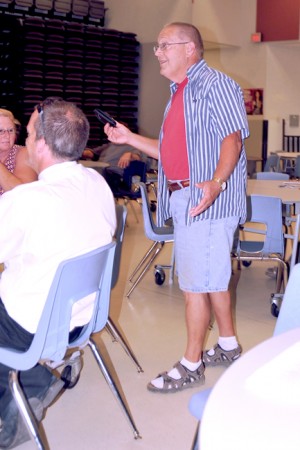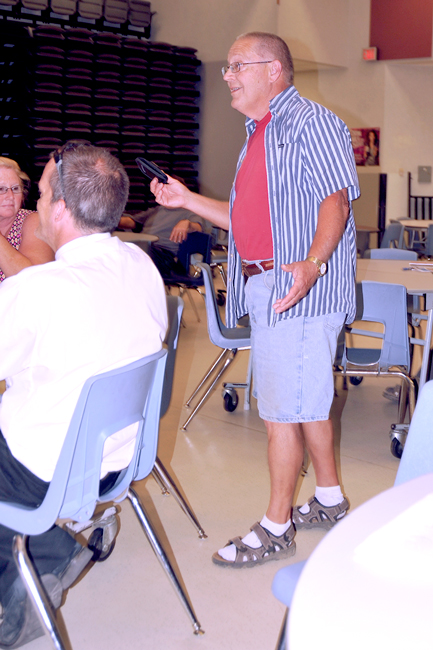Board looking for more input on arming teachers
OROVILLE – While it was advertised as a public input meeting on Gap training and the potential arming of trained school staff, most people who attended seemed to be content to listen to Jon Ladines founder of Force Dynamics explain his training programs.
The meeting, held last Monday, July 20, was called by Oroville School Board members who wanted to hear more about Landis’ training which he says gives staff other options rather than locking students away in the rooms and trying to hide them in the corner – a situation that could spell disaster if there is a “shooter” or other threat on school grounds.

Superintendent Steve Quick brought the training to the attention of the board after he had seen Landis speak at North Valley Hospital.
“When I did the training I saw that he did offer armed training of staff and I asked if we were able to do that in this state,” said Quick, who spoke with the two schools that have armed staff – Toppenish and Kiona Benton City School districts.
“I asked them how their community and students perceived it and they said there was a lot of support, although their were some who didn’t support it,” Quick said. “I asked Jon here to answer questions.”
Ladines spoke at length about the Gap training and his business, Force Dynamics. Gap is the time it takes law enforcement to arrive after they are made aware of a shooter or other threatening situation at a school, according to Landis, a former police officer and SWAT member who said he has worked with anti-terrorist teams.
After saying that school shootings are not new with recorded shootings going back to the beginning of this country, he said they became an issue 10 to 15 years ago.
“What we found is what we are doing to protect our children and staff is not working,” said Ladines.
He spoke at length about Sandy Hook, Columbine and other recent school shootings. He also said that schools were the number one target for these kinds of actions because of lack of security.
“They failed because they are not thinking like the shooter, they are thinking like the victim. At Columbine there were 35 wounded and 13 kids killed,” he said. “Can we avoid someone walking into a school… sometimes we can’t. But when you have a lockdown you lock the bad guys in and the good guys out.
“Just because there are police down the street doesn’t mean they can get there in time. Gap training helps staff to know what to do between the time the incident starts and police can arrive,” he said.
Landis said it doesn’t do any good to just lock the kids in a room, that the door needs to be barricaded because most doors alone do not provide an unsurmountable obstacle to a determine shooter or shooters. He said he could train staff how to spot potential threats and how to fight back. He also said that 98 percent of the places where he has trained staff do not have staff armed with concealed weapons.
Supt. Quick said the board had decided to do the Gap training for staff this year, but more community and staff input was needed before selected and trained staff would be allowed to carried a concealed weopon. he suggested the public call him at the district office or talk with current school board members, as well as those running for board positions in the fall.
When there was concern about whether the guns, if Oroville went that route, would be visible to students, Landis said there were rules that required them to be concealed and only revealed if they, staff or a student were being threatened.
Local businessman Spence Higby, a former school teacher and former school board member, as well as a licensed gun dealer, said he was carrying two concealed holsters on his person at that very moment, although they were empty.
Board chairman Rocky DeVon indicated he liked the option of training and arming certain staff.
Joseph Enzensberger said he wished the type of issues that have sometimes driven people to commit school shootings could be addressed.
Ladines said he would like to see that too, but when a shooting or other life threatening incident was occurring by then it was too late.
Supt. Quick said the school offered many programs to address things like bullying.
Ladines said stress is one of the biggest factors in surviving a threat – he said just dialing 911 can be a problem, especially with today’s modern phones. The training would help staff learn how not to panic when seconds could mean saving lives. He compared it to fire drills. He said schools spend lots of time practicing fire drills and that the last kid killed in a school fire was in the 1950s and before that in 1914. He put the question to the community about whether they think at least as much training should be done to prepare for what to do if a shooter or some other threat enters the school campus.






